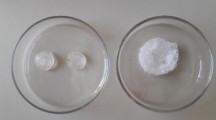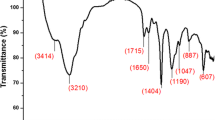Abstract
Poly(N-vinyl formamide-co-acrylamide) hydrogels were prepared by free radical chain polymerization using ammonium persulfate as redox initiator, N,N-Methylene bisacrylamide as crosslinker, and N, Nʹ, Nʹʹ, Nʹʹʹ-tetramethyl ethylenediamine as accelerator. The synthesis of hydrogels was confirmed by FTIR and SEM. The effect of compositional change and temperature on the mechanical and rheological behavior was explored in detail. Different rheological tests (flow curve, frequency sweep, creep recovery, and hysteresis loop) were conducted to study the effect of temperature (25–40 ℃), compositional change, and N-vinyl formamide concentration on the viscoelastic thixotropic behavior of copolymer hydrogels. Different rheological models (Bingham, modified Bingham, and Ostwald power law) were applied to check the pseudo plastic shear thinning non-Newtonian behavior, as confirmed by decline in viscosity with shear rate. Highly rough and microporous morphology, high thixotropy (hysteresis loop area of 4498.5 Pa s−1 obtained from the hysteresis loop test), and better recovery percentage (95% form creep recovery) were observed for hydrogels having increased N-vinyl formamide (NVF) concentration. The obtained results showed an increase in mechanical strength with increasing NVF concentration in the hydrogels and their valuable applications for wastewater treatment, drugs delivery, cosmetics and so on.
Graphical abstract










Similar content being viewed by others
References
Chai Q, Jiao Y, Yu X (2017) Hydrogels for biomedical applications: their characteristics and the mechanisms behind them. Gels 3:6
Khan M, Shah LA, Khan MA, Khattak NS, Zhao H (2020) Synthesis of an un-modified gum arabic and acrylic acid based physically cross-linked hydrogels with high mechanical, self-sustainable and self-healable performance. Mater Sci Eng C 116:111278
Khan M, Shah LA, Rehman T, Khan A, Iqbal A, Ullah M, Alam S (2020) Synthesis of physically cross-linked gum Arabic-based polymer hydrogels with enhanced mechanical, load bearing and shape memory behavior. Iran Polym J 29:351–360
Shah LA, Haleem A, Sayed M, Siddiq M (2016) Synthesis of sensitive hybrid polymer microgels for catalytic reduction of organic pollutants. J Environ Chem Eng 4:3492–3497
Ciolacu DE, Suflet DM (2018). In: Popa VI, Volf I (eds) Biomass as renewable raw material to obtain bioproducts of high-tech value. Elsevier
Shah LA (2019) Developing Ag-tercopolymer microgels for the catalytic reduction of p-nitrophenol and EosinY throughout the entire pH range. J Mol Liq 288:111045
Zhao T, Wang G, Hao D, Chen L, Liu K, Liu M (2018) Macroscopic layered organogel-hydrogel hybrids with controllable wetting and swelling performance. Adv Funct Mater 28:1800793
Khan SA, Shah LA, Shah M, Jamil I (2021) Engineering of 3D polymer network hydrogels for biomedical applications: a review. Polym Bull 12:1–21
Bakravi A, Ahamadian Y, Hashemi H, Namazi H (2018) Synthesis of gelatin-based biodegradable hydrogel nanocomposite and their application as drug delivery agent. Adv Polym Technol 37:2625–2635
Driest PJ, Allijn IE, Dijkstra DJ, Stamatialis D, Grijpma DW (2020) Poly (ethylene glycol)-based poly (urethane isocyanurate) hydrogels for contact lens applications. Polym Int 69:131–139
Parente M, Ochoa Andrade A, Ares G, Russo F, Jiménez-Kairuz Á (2015) Bioadhesive hydrogels for cosmetic applications. Int J Cosmetic Sci 37:511–518
Tanan W, Panichpakdee J, Saengsuwan S (2019) Novel biodegradable hydrogel based on natural polymers: synthesis, characterization, swelling/reswelling and biodegradability. Eur Polym J 112:678–687
Rehman TU, Shah LA, Khan M, Irfan M, Khattak NS (2019) Zwitterionic superabsorbent polymer hydrogels for efficient and selective removal of organic dyes. RSC Adv 9:18565–18577
Rehman TU, Bibi S, Khan M, Ali I, Shah LA, Khan A, Ateeq M (2019) Fabrication of stable superabsorbent hydrogels for successful removal of crystal violet from waste water. RSC Adv 9:40051–40061
Subhan H, Alam S, Shah LA, Ali MW, Farooq M (2021) Sodium alginate grafted poly (N-vinyl formamide-co-acrylic acid)-bentonite clay hybrid hydrogel for sorptive removal of methylene green from wastewater. Colloids Surf A 611:125853
Jiang H, Wang Z, Geng H, Song X, Zeng H, Zhi C (2017) Highly flexible and self-healable thermal interface material based on boron nitride nanosheets and a dual cross-linked hydrogel. ACS Appl Mater Interfaces 9:10078–10084
Feng Z, Zuo H, Gao W, Ning N, Tian M, Zhang L (2018) A Robust, self-healable, and shape memory supramolecular hydrogel by multiple hydrogen bonding interactions. Macromol Rap Commun 39:1800138
Hajebi S, Abdollahi A, Roghani-Mamaqani H, Salami-Kalajahi M (2020) Temperature-responsive poly (N-isopropylacrylamide) nanogels: the role of hollow cavities and different shell cross-linking densities on doxorubicin loading and release. Langmuir 36:2683–2694
Aalaie J, Vasheghani-Farahani E (2012) Swelling behavior of sulfonated polyacrylamide nanocomposite hydrogels in electrolyte solutions: comparison of theoretical and experimental results. Iran Polym J 21:175–183
Ali MAM, Alsabagh AM, Sabaa MW, El-Salamony RA, Mohamed RR, Morsi RE (2020) Polyacrylamide hybrid nanocomposites hydrogels for efficient water treatment. Iran Polym J 29:455–466
Kaşgöz H, Özgümüş S, Orbay M (2003) Modified polyacrylamide hydrogels and their application in removal of heavy metal ions. Polymer 44:1785–1793
Hajebi S, Abdollahi A, Roghani-Mamaqani H, Salami-Kalajahi M (2019) Hybrid and hollow Poly (N, N-dimethylaminoethyl methacrylate) nanogels as stimuli-responsive carriers for controlled release of doxorubicin. Polymer 180:121716
Zareie C, Sefti MV, Bahramian AR, Salehi MB (2018) A polyacrylamide hydrogel for application at high temperature and salinity tolerance in temporary well plugging. Iran Polym J 27:577–587
Gupta P, Purwar R (2021) Influence of cross-linkers on the properties of cotton grafted poly (acrylamide-co-acrylic acid) hydrogel composite: swelling and drug release kinetics. Iran Polym J 30:381–391
Rahmani Z, Sahraei R, Ghaemy M (2018) Preparation of spherical porous hydrogel beads based on ion-crosslinked gum tragacanth and graphene oxide: study of drug delivery behavior. Carbohydr Polym 194:34–42
Zhu X, Zhang F, Zhang L, Zhang L, Song Y, Jiang T, Sayed S, Lu C, Wang X, Sun J (2018) A highly stretchable cross-linked polyacrylamide hydrogel as an effective binder for silicon and sulfur electrodes toward durable lithium-ion storage. Adv Funct Mater 28:1705015
Mukhopadhyay P, Sarkar K, Bhattacharya S, Bhattacharyya A, Mishra R, Kundu P (2014) pH sensitive N-succinyl chitosan grafted polyacrylamide hydrogel for oral insulin delivery. Carbohydr Polym 112:627–637
Sokol ER, Karram MM, Dmochowski R (2014) Efficacy and safety of polyacrylamide hydrogel for the treatment of female stress incontinence: a randomized, prospective, multicenter North American study. J Urol 192:843–849
Peng H, Huang X, Melle A, Karperien M, Pich A (2019) Redox-responsive degradable prodrug nanogels for intracellular drug delivery by crosslinking of amine-functionalized poly (N-vinylpyrrolidone) copolymers. J Colloid Interface Sci 540:612–622
Gui Q, Ouyang Q, Zhang J, Shi S, Chen X (2021) Ultrahigh flux and strong affinity poly (N-vinylformamide)-grafted polypropylene membranes for continuous removal of organic micropollutants from water. ACS Appl Mater Interfaces 13:20796–20809
Bialczyk J, Kochanowski A, Czaja-Prokop U, Chrapusta E (2014) Removal of microcystin-LR from water by polymers based on N-vinylformamide structure. Water Supply 14:230–237
Marhefka JN, Marascalco PJ, Chapman TM, Russell AJ, Kameneva MV (2006) Poly (N-vinylformamide) a drag-reducing polymer for biomedical applications. Biomacromol 7:1597–1603
Sheikholeslami P, Muirhead B, Baek DSH, Wang H, Zhao X, Sivakumaran D, Boyd S, Sheardown H, Hoare T (2015) Hydrophobically-modified poly (vinyl pyrrolidone) as a physically-associative, shear-responsive ophthalmic hydrogel. Exper Eye Res 137:18–31
Świder J, Tąta A, Sokołowska K, Witek E, Proniewicz E (2015) Studies on N-vinylformamide cross-linked copolymers. J Mol Structure 1102:42–49
Xiong C, Wei F, Li W, Liu P, Wu Y, Dai M, Chen J (2018) Mechanism of polyacrylamide hydrogel instability on high-temperature conditions. ACS Omega 3:10716–10724
Bashir S, Teo YY, Ramesh S, Ramesh K (2017) Physico-chemical characterization of pH-sensitive N-Succinyl chitosan-g-poly (acrylamide-co-acrylic acid) hydrogels and in vitro drug release studies. Polym Degrad Stab 139:38–54
Bochek A, Shevchuk I, Gavrilova I, Nesterova N, Panarin E, Yudin V, Lebedeva M, Popova E, Kalyuzhnaya L, Volchek B (2012) Compatibility of carboxymethyl cellulose ionized to various degrees with poly-N-vinylformamide in composite films. Russian J Appl Chem 85:1413–1421
Ajiro H, Kan K, Akashi M (2017) Thermal treatment of poly (N-vinylformamide) produced hydrogels without the use of chemical crosslinkers. J Nanosci Nanotechnol 17:837–841
Chauhan G, Verma A, Das A, Ojha K (2018) Rheological studies and optimization of Herschel-Bulkley flow parameters of viscous karaya polymer suspensions using GA and PSO algorithms. Rheol Acta 57:267–285
Nair R, Choudhury AR (2020) Synthesis and rheological characterization of a novel shear thinning levan gellan hydrogel. Int J Biolog Macromol 159:922–930
Huang Y, Zheng W, Zhang D, Xi Y (2020) A modified Herschel-Bulkley model for rheological properties with temperature response characteristics of poly-sulfonated drilling fluid. Energy Sources Part A 42:1464–1475
Zandi N, Sani ES, Mostafavi E, Ibrahim DM, Saleh B, Shokrgozar MA, Tamjid E, Weiss PS, Simchi A, Annabi N (2021) Nanoengineered shear-thinning and bioprintable hydrogel as a versatile platform for biomedical applications. Biomaterials 267:120476
Rehman TU, Shah LA (2019) Rheological investigation of GO doped p (APTMACl) composite hydrogel. Z Phys Chem 2019:1416
Ali I, Shah LA (2020) Rheological investigation of the viscoelastic thixotropic behavior of synthesized polyethylene glycol-modified polyacrylamide hydrogels using different accelerators. Polym Bull 78:1275–1291
Irfan M, Khan M, ur Rehman T, Ali I, Shah LA, Khattak NS, Khan MS (2021) Synthesis and rheological survey of xanthan gum based terpolymeric hydrogels. Z Phys Chem 235:609–628
Jafarigol E, Salehi MB, Mortaheb HR (2021) Synergetic effects of additives on structural properties of acrylamide-based hydrogel. J Dispers Sci Technol 42:910–919
Gong J, Wang L, Wu J, Yuan Y, Mu RJ, Du Y, Wu C, Pang J (2019) The rheological and physicochemical properties of a novel thermosensitive hydrogel based on konjac glucomannan/gum tragacanth. LWT 100:271–277
Ma J, Lin Y, Chen X, Zhao B, Zhang J (2014) Flow behavior, thixotropy and dynamical viscoelasticity of sodium alginate aqueous solutions. Food Hydrocolloids 38:119–128
Zhu L, Qiu J, Sakai E (2017) A high modulus hydrogel obtained from hydrogen bond reconstruction and its application in vibration damper. RSC Adv 7:43755–43763
Ye L, Wang C, Wang S, Zhou S, Liu X (2016) Thermal and rheological properties of brown flour from Indica rice. J Cereal Sci 70:270–274
Acknowledgements
Higher Education Commission of Pakistan is gratefully acknowledge for financial support under research project No. 7309.
Author information
Authors and Affiliations
Corresponding author
Ethics declarations
Conflict of interest
No conflict of interest exists to declare.
Rights and permissions
About this article
Cite this article
Shah, L.A., Gul, K., Ali, I. et al. Poly (N-vinyl formamide-co-acrylamide) hydrogels: synthesis, composition and rheology. Iran Polym J 31, 845–856 (2022). https://doi.org/10.1007/s13726-022-01043-x
Received:
Accepted:
Published:
Issue Date:
DOI: https://doi.org/10.1007/s13726-022-01043-x




